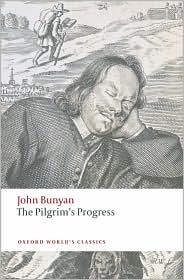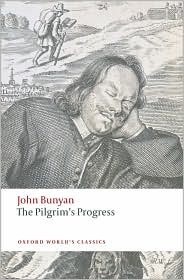STUDY SESSION 5
Introduction (pp. 55-66)
Christian needed good Christian fellowship and he meets with Faithful after braving the “Valley of the shadow of Death. “ Faithful tells of his own personal encounters. After a season of godly fellowship, they run into Talkative which opens up for them another important opportunity to discuss holy matters.
Readers
Narrator (66) – a shorter role though by no means very short
Christian (67) – a great amount
Faithful (67) – more than Christian
Talkative (74) – several pages
Vocabulary
Vale (67) = valley
bedabled (68) = bedabbled, namely, to wet or soil by dabbling
“writ for a wonder” (69, see †) = “it would be surprising”
tro (69) = trow (believe, think)
hectoring (72, 73) = intimidate, harass, bully
Prating-row (76) = from “prate” (pratingly is the adverb) to chatter, talk long and idly
bruit (77) = pronounced like “brute”; it means noise, report, rumor, etc.
churl (77) = a rude ill-bred person; peasant like
Turk (77) = often used to mean a Muslim
“you lie at the catch (80, see †) = “you are watching for an opportunity to catch me out”
peevish (82) = easily irritated or bothered
Questions (pp. 66-83)
Page #
66 Explain what “Pope and Pagan” meant. Why did he not fear them? Was his assessment of “Pagan” accurate? Of Pope?
69 What allure does “Wanton” represent (69)? Is that a concern in our generation? How is the proverb (22:14) cited by Christian relevant to the situation? What did he mean he wasn’t sure if he wholly escaped her? [
69-70 The “Old Man” was “Adam the first.” What does he represent? Who is this man that kept knocking Faithful down? What is the point of this encounter? How do we avoid this danger or pitfall?
71 Faithful met Discontent in the Valley of Humility. What was Discontent’s method of argumentation?
72 Summarize Shame’s line of argument. Is his argument used today? What was Faithful’s response? Which for you is more formidable, Discontent or Shame?
76 Is “Talkative” someone we might run into? What would he or she look like? How does Christian describe him? What kind of “religion” is found in Talkative’s house (77)?
79-80 In discussing the grace of God in the heart, Talkative mentions his first point. What was it and why did Faithful insist in making a distinction from Talkative’s first point? Explain Faithful’s answer.
80 Isn’t a great knowledge of Gospel Mysteries a sure sign that a person is a genuine convert? What was Faithful’s response? Is he right?
81 Faithful further explains what “grace in the soul” looks like. What is “an experimental confession”? Also, how does Faithful’s explanation unmask Talkative’s religion? What is the difference?
Observations & Notes
POPE AND PAGAN (66)
This is one of those curious historic observations Bunyan made which turned out to be incorrect. He viewed the two giants as being practically dead. Paganism suffered a severe blow in the seventeenth century but it grew in great force in the eighteenth. Papism never died and had (and still has) more power than Bunyan expected. However, Catholicism did not have the official backing like it used to in England. Perhaps it was his limited understanding of the world that made him view Catholicism as being so weak or as Calhoun suggested, maybe he had an expectation according to God’s purpose for his Church.[1] [The “old man” papism talks about more people being burned. This is a reference to Queen Mary’s bloody reign. Regarding this, Fox’s Acts and Monuments gives a thorough account and this book was the only other books Bunyan had next to the Bible (while in prison).]
This scene has been changed in the Dangerous Journey (where Paganism is alive and Papism is the same). Some versions delete the scene entirely.[2] Paganism is a growing giant in our generation and historians of philosophical ideas have shown that it had not really died during Bunyan’s era (it merely did not have the political clout to influence society).[3]
SEVEN TIMES WORSE (68)
This is probably a reference to Luke 11:26, “Then it goes and takes along seven other spirits more evil than itself, and they go in and live there; and the last state of that man becomes worse than the first.” Pliable’s state is worse off than before. Apostasy does not just place a man in the same situation as before; it makes him worse. (cf. 2 Pet. 2:22)
WANTON (69)
Spurgeon’s words on Faithful’s statement are sobering. “I know not whether I did wholly escape her, or no.”
The probability is, that the temptations of the flesh, even when resisted, do us an injury. If the coals do not burn us, they blacken us. The very thought of evil, and especially of such evil, is sin. We can hardly read a newspaper report of anything of this kind without having our minds in some degree defiled. There are certain flowers which matters that they scatter an ill savour as they are repeated in our ears. So much for Wanton’s assault on Faithful. From her net, and her ditch, may every pilgrim be preserved!”[4]
ADAM THE FIRST AND MOSES (70-71)
Puritans held a variety of views concerning the relationship between the covenant made with Adam (Covenant of Works) and the one made with Moses (Mosaic Covenant). Many of them believed that the Mosaic Covenant was a re-publication of the Covenant of Works and in some manner very similar to it.[5] Yet, the Mosaic Covenant had an element of grace through its sacrificial system and promises.
This encounter teaches that once a believer looks to the old way of trusting in his human efforts to save himself, he will be pummeled with the harsh demands of the law — there can be no mercy in the Law. To obey the law because one is saved is proper but to be inclined towards the law (to Adam the First) in the sense depicted by Bunyan is to court spiritual disaster and death.
TRUE GOSPEL SENSE OF THOSE TEXTS (79)
Puritans believed in “typological” interpretations. Namely, there is the literal sense but also a deeper Gospel sense to many parts of the Bible. It is different from the true allegorical sense found in Medieval theologians who believed each passage had four senses to it. What is truly wonderful and edifying about the Puritans was their insistence on digging deeper to gain something beneficial for their souls. We see something similar in Spurgeon. Many modern readers and exegetes find this method to be distasteful.
[1] Cf. Calhoun, Grace Abounding, 81-82 n.40.
[2] Cf. Horner, Pilgrim’s Progress: Themes and Issues, 420-422.
[3] For example, Thomas Hobbes is a good example of a type of paganism against whom men like Cudworth devoted their intellectual attacks. In the end of seventeenth century, “Deism” began to develop. Cf. Alister McGrath, The Twilight of Atheism: The Rise and Fall of Disbelief in the Modern World (New York: Doubleday, 2004).
[4] Spurgeon, Pictures from Pilgrim’s Progress, 146-147. Also, see Bradley’s helpful observations in her study, p. 49.
[5] Cf. Pieter de Vries, John Bunyan on the Order of Salvation, translated by C. van Haaften (New York: Peter Lang, 1994), 100-102.


